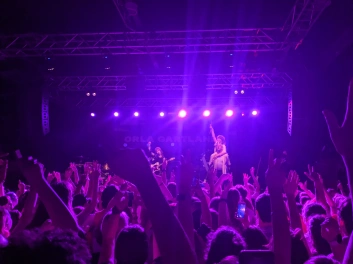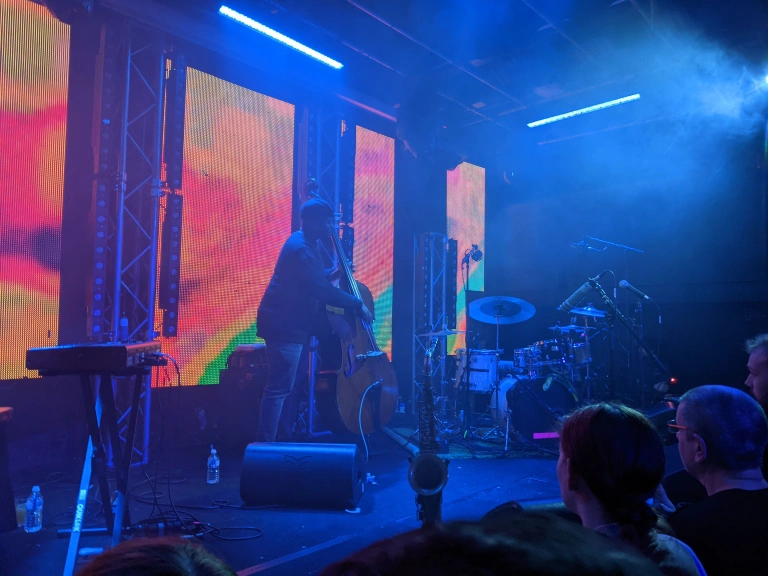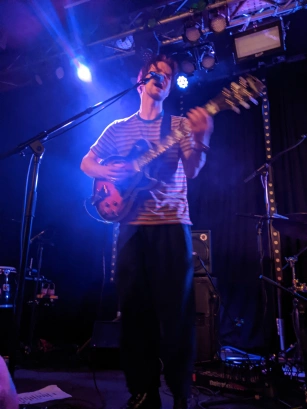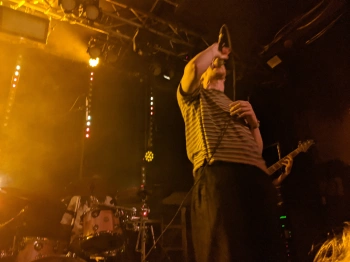Top 15 Bass-Heavy Workout Albums (Ranked by Intensity)
1. Hybrid Riot – “Neuro Bass Assault” (2026)
Genre: Neurofunk / Drum & Bass | Avg BPM: 174
Album cover alt: Hybrid Riot in full gear dropping neck-snapping neurofunk bass.
- Insane, razor-sharp basslines that fuel every rep
- Keeps your heart pounding with unrelenting breakbeats
- Perfect for lifting heavy or crushing sprints🔥
Standout Tracks: “Bassquake,” “Lift Off,” “Neurocharge”
Stream: Spotify / Apple Music / YouTube / Bandcamp
Intensity: 9.5/10
2. Rusko – “Riddim Revolt” (2026)
Genre: Dubstep / Riddim | Avg BPM: 140
Album cover alt: Rusko’s fiery riddim bass shaking the gym ceilings.
- Face-melting bass drops to smash plateaus
- Wicked wobble and aggressive bass growls that lift the vibe
- Endless motivation for those tearout dubstep sessions
Standout Tracks: “Grindstone,” “Bass Detonator,” “Riddim Rush”
Stream: Spotify / Apple Music / YouTube / Bandcamp
Intensity: 9/10
3. Noisia – “Split The Atom 2.0” (2022)
Genre: Neurofunk / Drum & Bass | Avg BPM: 172
Album cover alt: Noisia’s signature dark bass smashing through speakers.
- Complex sound design to keep you locked in
- High-octane bass hits for focused weightlifting madness
- Keeps a steady, fast pace for cardio or strength workouts
Standout Tracks: “Machine Gun Reloaded,” “Dead Limit,” “Collider”
Stream: Spotify / Apple Music / YouTube / Bandcamp
Intensity: 9.3/10
4. Flosstradamus – “BASSHEAD HYPE” (2026)
Genre: Bass House / Trap | Avg BPM: 130
Album cover alt: Flosstradamus throwing down bass house beats that hit like a wrecking ball.
- Heavy bass drops to amp up your workout energy
- Perfect blend of trap aggression and bass house grooves
- Keeps you hyped for long sets or brutal lifting sessions
Standout Tracks: “Bass Cannon,” “Wreckhouse,” “Trap Slam”
Stream: Spotify / Apple Music / YouTube / Bandcamp
Intensity: 8.7/10
5. Virtual Riot – “Bassline Madness” (2026)
Genre: Dubstep / Hybrid Trap | Avg BPM: 142
Album cover alt: Virtual Riot flexing heavy bass drops and glitchy synths.
- Raw energy that makes you want to deadlift a truck
- Hybrid trap influences offer big melodic breaks between brutal bass hits
- Perfect for those mid-workout peak moments
Standout Tracks: “Face Melter,” “Glitch Banger,” “Bassline Frenzy”
Stream: Spotify / Apple Music / YouTube / Bandcamp
Intensity: 8.9/10
Quick Intensity Ratings
- 9.5 – Hybrid Riot – Neuro Bass Assault
- 9.3 – Noisia – Split The Atom 2.0
- 9.0 – Rusko – Riddim Revolt
- 8.9 – Virtual Riot – Bassline Madness
- 8.7 – Flosstradamus – BASSHEAD HYPE
Ready for a full-on bass assault in your next workout? These albums deliver the goods—massive drops, killer grooves, and relentless energy to power you through every set.
Bonus: 2026 Upcoming Bass Albums to Watch
Keeping your workout fresh means staying ahead with the newest bass-heavy releases. Here are some of the most anticipated 2026 bass albums that promise high energy and heavy drops to power your sessions:
-
Subtronics – Riddim Nation 3 (Bass, Dubstep, 150+ BPM)
Expect aggressive bass drops and relentless riddim vibes, perfect for weightlifting and high-intensity cardio bursts.
-
Noisia – Outer Edges II (Neurofunk, Drum and Bass, 170 BPM)
Following their groundbreaking sound, this neurofunk album is set to deliver sharp, dark basslines that push your limits.
-
Zeds Dead – Echoes (Bass House, Hybrid Trap, 140-150 BPM)
A smooth blend of bass house and trap, ideal for warming up and maintaining momentum through mixed workout routines.
-
Excision – Apocalyptica (Heavy Dubstep, Bass, 140 BPM)
Known for festival dubstep, this release promises earth-shaking bass drops to keep motivation high during intense lifting sessions.
-
REZZ – Hypnotic Frequencies (Mid-Tempo Bass, 110-130 BPM)
For those preferring a groove-driven yet powerful bass workout vibe, this album offers hypnotic beats and deep basslines.
These albums are projected to redefine pre-workout music albums in 2026 with aggressive electronic music and heavy bass drops motivation that gym enthusiasts crave. Keep an eye out on streaming platforms like Spotify and Apple Music as these releases drop—you won’t want to miss adding them to your bass house gym playlist or neurofunk lifting music rotation.
For a taste of high-intensity bass music perfect for workouts, check out closely related emerging artists and releases in our deep dive on undertones artists to watch, which highlights fresh talent shaping next-level soundscapes.
How to Build the Ultimate Bass Workout Playlist from These Albums
Creating the perfect bass-heavy workout playlist takes more than just picking your favorite tracks. To keep energy high and motivation steady, structure your playlist with a clear flow—warm-up, peak, and cool-down. Here’s how to get the most out of the bass music albums featured:
Recommended Track Order for a 60-Minute Session
- Warm-Up (0-15 mins): Start with tracks at a moderate BPM (around 120-130). Think bass house or hybrid trap with steady but controlled beats. This primes your muscles without burning out early.
- Peak (15-45 mins): Time to crank it up! Use high-energy drum and bass, neurofunk, or heavy dubstep with BPM pushing 150-170+. This is where aggressive electronic music with heavy bass drops and riddim vibes will keep your intensity at max.
- Cool-Down (45-60 mins): End with slightly slower bass tracks around 110-120 BPM to help your heart rate gradually drop. Choose more melodic or spacey bass tunes without losing groove.
BPM Ramp-Up Guide
- Start light, increasing BPM by about 5-10 every 5 minutes during warm-up
- Push your limits mid-session with consistent 160+ BPM bass music for cardio and weightlifting
- Lower the BPM gradually in the last 15 minutes to avoid abrupt energy drops or muscle soreness
This approach mirrors the natural energy curve of a workout and taps into the power of pre-workout music albums and heavy bass drops motivation. Use streaming platforms like Spotify or Apple Music to customize your order easily and explore specific workouts matching the tempo.
For a fresh take on maintaining steady workout motivation with bass, check recent insights like the Soft Play Heavy Jelly review to discover albums that balance intensity and flow perfectly.
With this playlist structure, your workout won’t just have sound—it’ll have the pulse of powerful bass music driving every rep and run.
Frequently Asked Questions
What BPM is best for lifting vs cardio?
- For lifting and strength training, slower to moderate tempos around 120-140 BPM work best. They keep you focused and motivated without burning out too quickly.
- For cardio and running, faster BPMs of 150-180+ provide the high energy and rhythm to keep your pace up, especially for drum and bass or bass-heavy running playlists.
Where can I download these albums offline?
- Use official platforms like Spotify Premium, Apple Music, and Bandcamp for offline downloads. These services let you save full albums and playlists directly to your device for gym sessions without data use.
- Always choose legitimate sources to support the artists and get quality audio files.
Are there cleaner (radio edit) versions for public gyms?
- Many bass-heavy workout albums offer radio edits or clean versions on streaming services. These remove explicit lyrics and heavy profanity, making them suitable for public or family-friendly gym settings.
- Check the album details or look for “clean” versions specifically if you need a more gym-appropriate mix.
What are the best headphones/earbuds for heavy bass in 2026?
- Look for headphones with excellent bass response and noise isolation. Some top picks include:
- Sony WH-1000XM5 – well-balanced with powerful bass and industry-leading noise cancellation.
- Beats Fit Pro – super bass-heavy, perfect for EDM and bass house workouts.
- Bose QuietComfort Earbuds II – clear sound with strong bass and comfort for long sessions.
- Wireless earbuds that stay secure during movement are a big plus for workouts.
- Avoid overly bright or treble-heavy headphones to maintain that low-end punch in your workout tracks.
For more on high-energy workouts, check out our best songs of 2026 for intense sessions.




